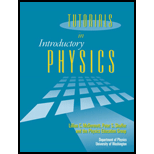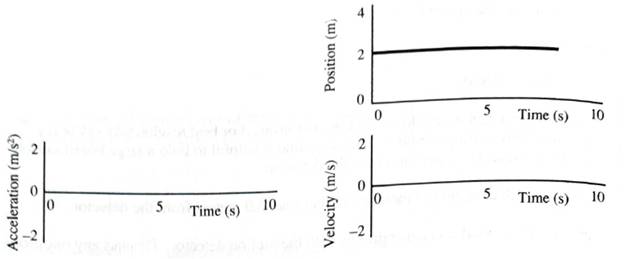
Tutorials in Introductory Physics
1st Edition
ISBN: 9780130970695
Author: Peter S. Shaffer, Lillian C. McDermott
Publisher: Addison Wesley
expand_more
expand_more
format_list_bulleted
Concept explainers
Textbook Question
Chapter 1.2, Problem 1bT
Description of Motion:

Expert Solution & Answer
Trending nowThis is a popular solution!
Learn your wayIncludes step-by-step video

schedule01:07
Students have asked these similar questions
2
3
Imagine you are out for a stroll on a sunny day when you encounter a lake. Unpolarized light from the sun is reflected off the lake into your eyes. However, you notice when you put on your vertically polarized sunglasses, the light reflected off the lake no longer reaches your eyes. What is the angle between the unpolarized light and the surface of the water, in degrees, measured from the horizontal? You may assume the index of refraction of air is nair=1 and the index of refraction of water is nwater=1.33 . Round your answer to three significant figures. Just enter the number, nothing else.
Chapter 1 Solutions
Tutorials in Introductory Physics
Ch. 1.1 - Each person in your group should obtain a ruler...Ch. 1.1 - Each person in your group should obtain a ruler...Ch. 1.1 - Each person in your group should obtain a ruler...Ch. 1.1 - Each person in your group should obtain a ruler...Ch. 1.1 - Each person in your group should obtain a ruler...Ch. 1.1 - Each person in your group should obtain a ruler...Ch. 1.1 - Each person in your group should obtain a ruler...Ch. 1.1 - A. In the space below, sketch a possible ticker...Ch. 1.1 - B. Together with your classmates, take your ticker...Ch. 1.1 - C. Based on your observations of your tape segment...
Ch. 1.1 - D. Review your earlier interpretation of the speed...Ch. 1.1 - E. Suppose you selected two widely separated dots...Ch. 1.2 - The computer program assumes a particular...Ch. 1.2 - Description of Motion:Ch. 1.2 - Description of Motion:Ch. 1.2 - Description of Motion:Ch. 1.2 - How are the motions in parts C and D similar? How...Ch. 1.2 - Description of Motion:Ch. 1.2 - Description of Motion:Ch. 1.2 - Description of Motion: Move toward the detector...Ch. 1.2 - How do the acceleration graphs for F, G, and H...Ch. 1.2 - Description of Motion: Initially move away from...Ch. 1.2 - Description of Motion:Ch. 1.2 - Description of Motion:Ch. 1.2 - The term decelerate is often used to indicate that...Ch. 1.3 - Draw vectors on your diagram that represent the...Ch. 1.3 - B. In the space at right, compare the velocities...Ch. 1.3 - Consider the change in velocity vector between two...Ch. 1.3 - Use the definition of acceleration to draw a...Ch. 1.3 - Does the acceleration change as the ball rolls up...Ch. 1.3 - Generalize your results thus far to answer the...Ch. 1.3 - Choose two successive points. In the space at...Ch. 1.3 - In the space at right, draw a vector to represent...Ch. 1.3 - Choose a point before the turnaround and another...Ch. 1.3 - Suppose that you had chosen the turnaround as one...Ch. 1.3 - In the space at right, draw a vector that...Ch. 1.4 - Prob. 1aTCh. 1.4 - If you were to choose a different origin for the...Ch. 1.4 - On a separate part of your paper, copy the...Ch. 1.4 - Suppose you were to choose a new point on the...Ch. 1.4 - On a separate part of your paper, copy the...Ch. 1.4 - Suppose the object started from rest at point E...Ch. 1.4 - At several points on each of the diagrams below,...Ch. 1.5 - The second diagram at right shows the positions of...Ch. 1.5 - The picture of the spaceships and shuttle from the...Ch. 1.5 - Prob. 1cTCh. 1.5 - Spaceship C moves so as to remain a fixed distance...Ch. 1.5 - Consider the following statement: "The...Ch. 1.5 - Prob. 1fTCh. 1.5 - Describe the motion of the car and the truck...Ch. 1.5 - Complete the diagram at right by drawing the car...Ch. 1.5 - Use your completed diagram to sketch average...Ch. 1.5 - During a small time interval t from just before to...
Additional Science Textbook Solutions
Find more solutions based on key concepts
Modified True/False 9. A giant bacterium that is large enough to be seen without a microscope is Selenomonas.
Microbiology with Diseases by Body System (5th Edition)
Two culture media were inoculated with four different bacteria. After incubation, the following results were ob...
Microbiology: An Introduction
Distinguish between microevolution, speciation, and macroevolution.
Campbell Essential Biology (7th Edition)
Explain all answers clearly, with complete sentences and proper essay structure if needed. An asterisk(*) desig...
Cosmic Perspective Fundamentals
What are the minimum and maximum ages of the island of Kauai? Minimum age: ______million yr Maximum age: ______...
Applications and Investigations in Earth Science (9th Edition)
47. A block hangs in equilibrium from a vertical spring. When a second identical block is added, the original ...
Physics for Scientists and Engineers: A Strategic Approach, Vol. 1 (Chs 1-21) (4th Edition)
Knowledge Booster
Learn more about
Need a deep-dive on the concept behind this application? Look no further. Learn more about this topic, physics and related others by exploring similar questions and additional content below.Similar questions
- 20. Two small conducting spheres are placed on top of insulating pads. The 3.7 × 10-10 C sphere is fixed whie the 3.0 × 107 C sphere, initially at rest, is free to move. The mass of each sphere is 0.09 kg. If the spheres are initially 0.10 m apart, how fast will the sphere be moving when they are 1.5 m apart?arrow_forwardpls help on allarrow_forwardpls help on thesearrow_forward
- pls help on all asked questions kindlyarrow_forwardpls help on all asked questions kindlyarrow_forward19. Mount Everest, Earth's highest mountain above sea level, has a peak of 8849 m above sea level. Assume that sea level defines the height of Earth's surface. (re = 6.38 × 106 m, ME = 5.98 × 1024 kg, G = 6.67 × 10 -11 Nm²/kg²) a. Calculate the strength of Earth's gravitational field at a point at the peak of Mount Everest. b. What is the ratio of the strength of Earth's gravitational field at a point 644416m below the surface of the Earth to a point at the top of Mount Everest? C. A tourist watching the sunrise on top of Mount Everest observes a satellite orbiting Earth at an altitude 3580 km above his position. Determine the speed of the satellite.arrow_forward
- pls help on allarrow_forwardpls help on allarrow_forward6. As the distance between two charges decreases, the magnitude of the electric potential energy of the two-charge system: a) Always increases b) Always decreases c) Increases if the charges have the same sign, decreases if they have the opposite signs d) Increases if the charges have the opposite sign, decreases if they have the same sign 7. To analyze the motion of an elastic collision between two charged particles we use conservation of & a) Energy, Velocity b) Momentum, Force c) Mass, Momentum d) Energy, Momentum e) Kinetic Energy, Potential Energyarrow_forward
arrow_back_ios
SEE MORE QUESTIONS
arrow_forward_ios
Recommended textbooks for you
 College PhysicsPhysicsISBN:9781938168000Author:Paul Peter Urone, Roger HinrichsPublisher:OpenStax College
College PhysicsPhysicsISBN:9781938168000Author:Paul Peter Urone, Roger HinrichsPublisher:OpenStax College An Introduction to Physical SciencePhysicsISBN:9781305079137Author:James Shipman, Jerry D. Wilson, Charles A. Higgins, Omar TorresPublisher:Cengage Learning
An Introduction to Physical SciencePhysicsISBN:9781305079137Author:James Shipman, Jerry D. Wilson, Charles A. Higgins, Omar TorresPublisher:Cengage Learning Glencoe Physics: Principles and Problems, Student...PhysicsISBN:9780078807213Author:Paul W. ZitzewitzPublisher:Glencoe/McGraw-Hill
Glencoe Physics: Principles and Problems, Student...PhysicsISBN:9780078807213Author:Paul W. ZitzewitzPublisher:Glencoe/McGraw-Hill University Physics Volume 1PhysicsISBN:9781938168277Author:William Moebs, Samuel J. Ling, Jeff SannyPublisher:OpenStax - Rice University
University Physics Volume 1PhysicsISBN:9781938168277Author:William Moebs, Samuel J. Ling, Jeff SannyPublisher:OpenStax - Rice University College PhysicsPhysicsISBN:9781285737027Author:Raymond A. Serway, Chris VuillePublisher:Cengage Learning
College PhysicsPhysicsISBN:9781285737027Author:Raymond A. Serway, Chris VuillePublisher:Cengage Learning Principles of Physics: A Calculus-Based TextPhysicsISBN:9781133104261Author:Raymond A. Serway, John W. JewettPublisher:Cengage Learning
Principles of Physics: A Calculus-Based TextPhysicsISBN:9781133104261Author:Raymond A. Serway, John W. JewettPublisher:Cengage Learning

College Physics
Physics
ISBN:9781938168000
Author:Paul Peter Urone, Roger Hinrichs
Publisher:OpenStax College

An Introduction to Physical Science
Physics
ISBN:9781305079137
Author:James Shipman, Jerry D. Wilson, Charles A. Higgins, Omar Torres
Publisher:Cengage Learning

Glencoe Physics: Principles and Problems, Student...
Physics
ISBN:9780078807213
Author:Paul W. Zitzewitz
Publisher:Glencoe/McGraw-Hill

University Physics Volume 1
Physics
ISBN:9781938168277
Author:William Moebs, Samuel J. Ling, Jeff Sanny
Publisher:OpenStax - Rice University

College Physics
Physics
ISBN:9781285737027
Author:Raymond A. Serway, Chris Vuille
Publisher:Cengage Learning

Principles of Physics: A Calculus-Based Text
Physics
ISBN:9781133104261
Author:Raymond A. Serway, John W. Jewett
Publisher:Cengage Learning
Position/Velocity/Acceleration Part 1: Definitions; Author: Professor Dave explains;https://www.youtube.com/watch?v=4dCrkp8qgLU;License: Standard YouTube License, CC-BY